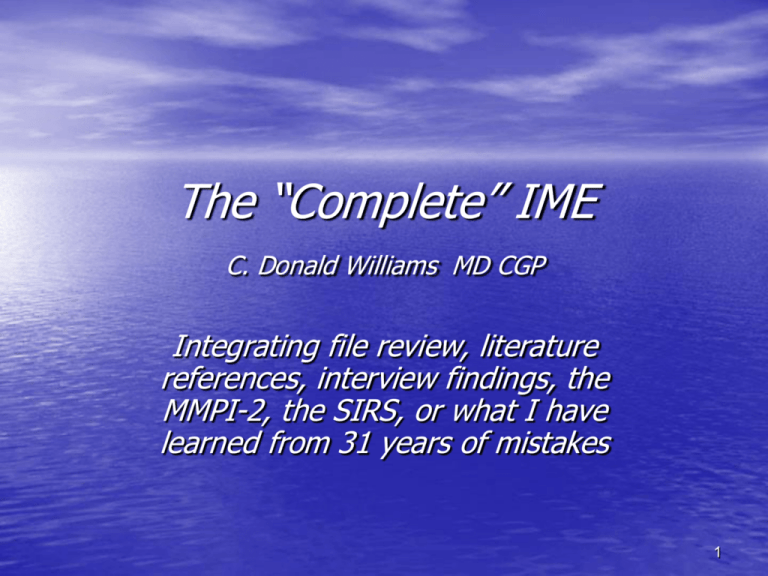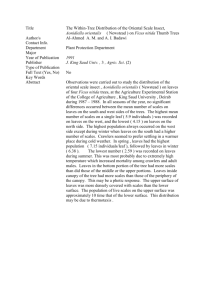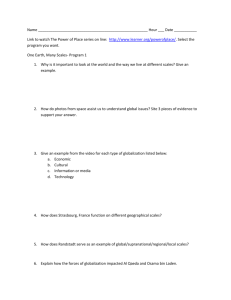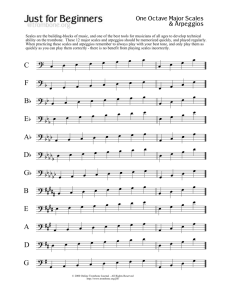The 'Complete' IME: Integrating the file review with literature
advertisement

The “Complete” IME C. Donald Williams MD CGP Integrating file review, literature references, interview findings, the MMPI-2, the SIRS, or what I have learned from 31 years of mistakes 1 2 Why this presentation? • Uneven quality of psychiatric IME’s “in the field” • Human cost—denial or delay of treatment with damage to individuals and families and broader cost to community • Economic waste—unnecessary litigation • Aim to set a new practice standard 3 Prerequisites for excellence • Diligence • Attention to detail • Humaneness • Moral clarity • Ingenuity – From Commonwealth Club lecture by Atul Gawande, MD Professor of Surgery, Harvard Medical School—transcript included with permission of Radio Australia 4 The “complete” IME… • Detailed line by line record review of… – All IME’s – All medical treatment, PCE’s, legal records – Surveillance videos—minute by minute • Detailed interview—90-120 minutes • Psychological testing – MMPI-2 – SIRS, other self report tests e.g. BDI-II, PHQ-9 • Logical synthesis of all elements • Some relevant literature references 5 Why “complete” IME’s are needed • High stakes and/or • Big file and/or • Conflict of opinion with sides dug in and/or • Poorly written prior IME’s and/or • When opinion will be challenged as a matter of policy of other side 6 Clarity of contract with client • Clear client expectations, i.e. no shaded • • outcomes Assignment letter with questions Resources you need – – – – Knowledge and experience Time—nights and weekends Staff to proofread Commitment of your practice – not a “sideline” • Time line for completion and delivery 7 Informed consent • Explicit examinee notification – Non-confidentiality – Who gets a copy of the report – No doctor patient relationship offered – Describe length of evaluation • Respectful of examinee • Query re: understanding 8 Psychological testing • Self report questionnaires such as BDI-II, Zung, and PHQ-9 easily challenged in litigation, but useful for treatment eval. • Objective and validated instruments stronger. – MMPI-II – SIRS (Structured Interview of Reported Symptoms) – TOMM (Test of Malingered Memory-neuropsychology) 9 One of today’s goals: develop surface familiarity with MMPI-2 and SIRS-Not to teach their use (also to recognize poor use of MMPI) 10 For quick overview of psychological testing, Google -‘Mmpi-2 profile psych 427’ [http://www.csun.edu/~gk45683/P427%20-%2014%20%20Structured%20Personality%20Tests%20-%20bw.pdf] “Structured Personality Tests Psych 427-Psychological Testing Gary S. Katz Ph.D.” 11 MMPI-2 • Validity scales • Clinical scales • Supplementary scales • All have raw scores which are converted to statistically defined T scores— – A T score of 90 has the same statistical meaning from one scale to another – Scores of >65 are interpretable 12 MMPI-2 • Validity scales -advantage over self report inventories—what was the “response set of test taker ?” – VRIN-variable response inconsistency to paired items – TRIN-measure of “fixed responding” to paired items – F-“inFrequency scale” higher scores=symptom exaggeration in normal population – Fb-“inFrequency back scale” items 371-567 normals – Fp-“inFrequency” scale for psychiatric inpatients – FBS—primarily related to head injury >29 suggests non-credible – L -higher scores=overly virtuous/naïve presentation-the “look good” profile – K -higher scores=unintentional underreporting 13 The numbers represent Clinical scales 1—Hs (hypochondriasis) 2—D (Depression) 3—Hy (Hysteria) 4—Pd (Psychopathic deviate) 5—Mf (Masculine/feminine) • 6—Pa (paranoia) • 7—Pt (psychasthenia “anxiety with obsessive compulsive features”) • 8—Sc (schizophrenia) • 9—Ma (mania) • 10—Si (social introversion) 14 Restructured Clinical Scales • Developed to capture demoralization, identify • • the “core components” of the clinical scales, related to but distinct from the Clinical scales. RCd, RC1 through RC9, each capturing the essential component of each scale, without the demoralization component. Example—RC2lpe identifies depression separately from demoralization; RC3som measures somatization separate from demoralization—will illustrate with clinical example 15 PSY-5 Scales • Personality psychopathology: were designed • • • to measure 5 broad personality traits, on the more pathologic end of the dimension. There is a great deal of evidence that these scales have utility. AGGR, PSYC, DISC, NEGE, INTR Stable over 5 years Do not directly correlate with specific Axis II diagnoses 16 “The Welsh code is 3”24861’+-70/95: FL+-/K” What does this mean? (Hint: Look at numbers, punctuation marks, letters, and underlines) 17 Welsh code profile T scores= punctuation marks (numbers) • • • • • 100 or more = ** 90-99 = * 80-89 = “ 70-79 = ‘ 65-69 = + • • • • • • 60-64 = – 50-59 = / 40-49 = : 30-39 = # 29 or less—no T scores below 30 _ joining Welsh symbols means scores identical (underlines) 18 To interpret an MMPI-2 • First establish validity by examining validity • • • • scale pattern, then, if valid…. Code types are patterns of scale elevations that have statistically demonstrated high correlations with clinical findings— more reliable than single scale interpretations Then interpret profile according to T scores, starting with highest Examine RC scales (purer content than clinical) Examine PSY-5 scales to assess stable traits 19 Validity and content scales same person 2008 & 2007 after one year of group and individual psychotherapy—note reduction of FBS and major reductions in scales 1 and 3 20 Restructured clinical (RC) scales same person 2008 & 2007—following one year of group and individual psychotherapy. Note reduction in lpe (depression) and som (somatization) 21 PSY-5 scales same person 2008 & 2007—Note relative stability of traits, although INTR is showing improvement with group and individual psychotherapy which we would expect with personality change. 22 Structured Interview of Reported Symptoms • Best validated measure of Malingering, especially when combined with MMPI-2. • Structured Interview of Reported Symptoms, • Richards R et al (1992) copyright PAR, Inc. “Structured Interviews and Dissimulation,” Rogers R, in Clinical Assessment of Malingering and Deception, Rogers R Ed, 2nd Edition, Guildford Press (1997) pp. 320-327. 23 24 25 26 27 Record review • Have staff arrange file according to file type (IME, Medical treatment records, Physical therapy records, Vocational records and Legal correspondence) and date, oldest to newest • List every file, with content summary when germane to psychiatric opinion 28 Report templates • Create your own, modify with experience • Save time • Prevents omission of important data • Standardizes presentation format 29 “Surveillance” uses and misuses 30 “Surveillance” • “An addendum letter dated September 28, 2004 prepared by Michael B. M.D. commented on surveillance videotapes. Dr. B. stated that he did not recognize the claimant. However, he nevertheless concluded that he suspected that she was not truthful in all aspects of her physical examination. On this basis he diagnosed probable malingering.” 31 Surveillance documentation • “Then Video Track 2 appears on the screen which is visualized from 00:00 through 01:29 in which she appears to be adjusting a garden hose and repositioning a yard sprinkler. Nothing is visualized from 01:35 until 02:10 when she emerges from behind a building and walks over in the direction of the utility building. She wanders around, limping, and then disappears behind the utility building at 02:39. Nothing is visualized between 02:39 until 02:54 when there is a break in the video sequence and she takes another drink from a bottle. She disappears inside the utility building at 03:00. Nothing is visualized from 03:00 until 04:50. That concludes Video Track 2.” 32 Sample surveillance video 33 Surveillance commentary— with literature citations for support • “In addition, information obtained from video surveillance is inherently • • subjective with no proven inter-rater reliability or statistical validation. This particular sequence has particularly significant shortcomings. It is a heavily edited, discontinuous, extremely small sample, and is of far less significance than a comprehensively validated psychological test instrument that has been administered to millions of people. Furthermore, there are no articles in the Journal of Occupational and Environmental Medicine that address the use of surveillance videos in malingering. In a search of PubMed (the database of all scientific health literature maintained by the National Library of Medicine and the National Institutes of Health there are only two articles, neither related to the issues in this case.[1] Consequently, it is my opinion that the surveillance videos are without substance. By contrast, the MMPI-2 and the SIRS have established validity and inter-rater reliability in the detection of malingering and factitious disorders.” [1] Westbrook LE et al. Nonepileptic seizures after head injury. Epilepsia. 1998 Sep;39(9):978-82. PMID: 9738677 [PubMed - indexed for MEDLINE] Kurlan R et al. Movement disorder in reflex sympathetic dystrophy: a case proven to be psychogenic by surveillance video monitoring. Mov Disord. 1997 Mar;12(2):243-5. No abstract available 34 Integration of records, interview, literature references, and testing Clarity and completeness 35 Sample assignment question response • • “Your diagnosis for conditions causally related to this industrial injury.” Response: “The diagnoses Major Depressive Disorder, single episode, moderate/severe and Pain Disorder associated with psychological factors and a general medical condition are causally related on a medically more probable than not basis to the industrial injury. Although Mr. Hxxxx has had serious problems with adjustment on account of his personality disorder throughout his entire life, he has not experienced a Major depression prior to this industrial injury. His personality disorder and its attendant rigidity rendered him significantly more vulnerable to the development of a Major depression because he has little adaptive capacity. There is a strong characterologic quality to his depressive disorder, but he satisfies DSM IV criteria for the diagnosis of MDD, and it is necessary to adhere strictly to diagnostic criteria in order to maintain consistency. Whether or not a claimant has personality traits that are irritating should not be allowed to interfere with an objective rating and diagnostic process.” 36 Category ppd ratings discussion • “Mr. Hxxxx presently reflects an impairment that most closely corresponds to a (high) • Category 4 level of mental health impairment, essentially just below the cutoff for a Category 3 rating. I do not believe that he is fixed and stable, however, and this estimate is my impression of his current impairment. With both orthopedic and psychopharmacologic treatment (but not with psychotherapy) he could improve to a Category 2 level, although the chance of this degree of improvement is probably less than 30%; it is more likely that with effective orthopedic intervention and antidepressant medication (prescribed by his regular physician) that he would plateau at Category 3. His pre-existing level of mental health impairment most closely corresponds to Category 2. Because the criteria as defined in WAC 296-20-340 utilize archaic language and because the rating scale has not been validated, and because as a result consistency in mental health impairment ratings has been difficult to achieve in the industrial insurance arena, I excerpted a table from a recent article[1] that proposes a correspondence among two validated rating scales and the WAC ratings. I boldfaced and underlined the criteria satisfied by Mr. Hxxxx under each of the three rating scales.” [1] Williams CD. “Psychiatric disability assessments.” Psychiatric Annals, 2006;36(11) 774-783 37 GAF 21-40 AMA Guide Class 4—Marked Impairment WAC 296-20-340 Some impairment in reality testing or communication (e.g., speech is at times illogical, obscure, or irrelevant) OR major impairment in several areas, such as work or school, family relations, judgment, thinking, or mood (e.g., depressed man avoids friends, neglects family, and is unable to work; child frequently beats up younger children, is defiant at home, and is failing at school). Behavior is considerably influenced by delusions or hallucinations OR serious impairment in communication or judgment (e.g., sometimes incoherent, acts grossly inappropriately, suicidal preoccupation) OR inability to function in almost all areas (e.g., stays in bed all day; no job, home, or friends). Impairment levels significantly impede useful functioning Very poor judgment, marked apprehension with startle reactions, foreboding leading to indecision, fear of being alone and/or insomnia; some psychomotor retardation or suicidal preoccupation; fear-motivated behavior causing moderate interference with daily life; frequently recurrent and disruptive organ dysfunction with pathology of organ or tissues; obsessivecompulsive reactions causing inability to work with others or adapt; episodic losses of physical function from hysterical or conversion reactions lasting longer than several weeks; misperceptions including sense of persecution or grandiosity which may cause domineering, irritable or suspicious behavior; thought disturbance causing memory loss that interferes with work or recreation; periods of confusion or vivid daydreams that cause withdrawal or reverie; deviations in social behavior which cause concern to others; lack of emotional control that is a nuisance to family and associates; moderate disturbance from organic brain disease such as to require a moderate amount of supervision and direction of work day activities. 38 Summary • • • • • • Detailed and documented record review Thorough interview Appropriate psychological testing and analysis Literature references to support conclusions Carefully explained rationale for conclusions Objectivity, detail, and careful reasoning without prejudice = Superior IME 39 • Further Issues and Questions? 40






